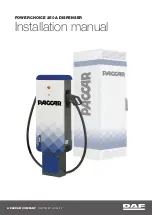
7-8
Starting and operating/Preparing to drive
.
A vehicle fails the OBDII inspection if
the
“
CHECK ENGINE
”
warning light is not
properly operating (light is illuminated or is
not working due to a burned out bulb) or
there is one or more diagnostic trouble
codes stored in the vehicle
’
s computer.
.
A state emission inspection may reject
(not pass or fail) a vehicle if the number of
OBDII system readiness monitors
“
NOT
READY
”
is greater than one. If the
vehicle
’
s battery has been recently re-
placed or disconnected, the OBDII system
inspection may indicate that the vehicle is
not ready for the emission test. Under this
condition, the vehicle driver should be
instructed to drive his/her vehicle for a few
days to reset the readiness monitors and
return for an emission re-inspection.
.
Owners of rejected or failing vehicles
should contact their SUBARU Dealer for
service.
Some states still use dynamometers in
their emission inspection program. A
dynamometer is a treadmill or roller-like
testing device that allows your vehicle
’
s
wheels to turn while the vehicle remains in
one place. Prior to your vehicle being put
on a dynamometer, tell your emission
inspector not to place your SUBARU
AWD vehicle on a two-wheel dynam-
ometer.
Otherwise, serious transmis-
sion damage will result.
The U.S. Environmental Protection
Agency (EPA) and states using two-wheel
dynamometers in their emission testing
program have EXEMPTED SUBARU
AWD vehicles from the portion of the
testing program that involves a two-wheel
dynamometer. There are some states that
use four-wheel dynamometers in their
testing program. When properly used, this
equipment should not damage a SUBARU
AWD vehicle.
Under no circumstances should the rear
wheels be jacked off the ground, nor
should the driveshaft be disconnected for
state emission testing.
Preparing to drive
You should perform the following checks
and adjustments every day before you
start driving.
1. Check that all windows, mirrors, and
lights are clean and unobstructed.
2. Check the appearance and condition
of the tires. Also check tires for proper
inflation.
3. Look under the vehicle for any sign of
leaks and check that no small animal is
under the vehicle.
4. Check that no small animal enters the
engine compartment.
5. Check that the hood and rear gate are
fully closed.
6. Check the adjustment of the seat.
7. Check the adjustment of the inside
and outside mirrors.
8. Fasten your seatbelt. Check that your
passengers have fastened their seatbelts.
9. Check the operation of the warning
and indicator lights when the ignition
switch is turned to the
“
ON
”
position.
10. Check the gauges, indicator and warn-
ing lights after starting the engine.
Summary of Contents for 2014 Forester
Page 1: ...2015 Forester Owner s Manual...
Page 3: ......
Page 4: ...This manual describes the following vehicle types...
Page 5: ......
Page 29: ......
Page 97: ......
Page 320: ...Audio Hands free system 5 61...
Page 321: ......
Page 343: ......
Page 421: ......
Page 443: ......
Page 513: ......
Page 530: ...Index 14...
Page 541: ......
Page 542: ......
Page 543: ......
Page 544: ......
















































